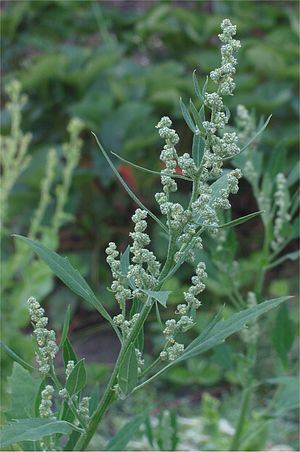Chenopodium album/ja: Difference between revisions
Created page with "== 分類{{Anchor|Taxonomy}} == ''Chenopodium album'' は複雑な分類を持ち、数多くの小種、亜種、変種に分けられてきたが、それらを区別するのは難しい。以下の変種が『Plants of the World Online』で認められている。 * ''Chenopodium album'' var. ''album'' – 温帯ユーラシア、インド亜大陸、北アフリカ、エチオピア * ''Chenopodium album..." Tags: Mobile edit Mobile web edit |
Created page with "album Category:Flora of Europe Category:Flora of temperate Asia Category:Flora of the Indian subcontinent Category:Flora of North Africa Category:Flora of Ethiopia Category:Edible nuts and seeds Category:Leaf vegetables Category:Plants described in 1753 Category:Plants used in Native American cuisine Category:Plants used in traditional African medicine Category:Taxa named by Carl Linnaeus {{二次利用..." |
||
| (19 intermediate revisions by the same user not shown) | |||
| Line 34: | Line 34: | ||
* ''Chenopodium album'' var. ''reticulatum'' {{small|(アエレン) ウオティラ}}(シノニム ''Chenopodium reticulatum'' {{small|アエレン}}) – フランスおよびイギリス | * ''Chenopodium album'' var. ''reticulatum'' {{small|(アエレン) ウオティラ}}(シノニム ''Chenopodium reticulatum'' {{small|アエレン}}) – フランスおよびイギリス | ||
==分布と生息地{{Anchor|Distribution and habitat}}== | |||
== Distribution and habitat == | その自生地は広範な栽培のために不明瞭であるが、[[:en:Europe|ヨーロッパ]]のほとんどの地域を含み、そこから[[:en:Carl Linnaeus|カール・リンネ]]が1753年にこの種を記載した。東アジア原産の植物は''C. album''に含まれるが、ヨーロッパの標本とは異なることが多い。『[[:en:Plants of the World Online|プランツ・オブ・ザ・ワールド・オンライン]]』によると、この種の自然分布には、西ヨーロッパから中国、[[:en:Russian Far East|ロシア極東]]までの温帯ユーラシア、[[:en:Indian subcontinent|インド亜大陸]]、[[:en:North Africa|北アフリカ]]、[[:en:Ethiopia|エチオピア]]、[[:en:United States|米国]]東部および中央部が含まれる。 | ||
その他の地域、例えば[[:en:Africa|アフリカ]]、[[:en:Australasia|オーストララシア]]、[[:en:North America|北アメリカ]]、[[:en:Oceania|オセアニア]]などにも広く帰化しており、現在では[[:en:Antarctica|南極]]を除くほぼすべての場所で、特に荒れ地の[[nitrogen/ja|窒素]]が豊富な土壌に生育している。 | |||
< | <span id="Cultivation"></span> | ||
== Cultivation == | == 栽培{{Anchor|Cultivation}} == | ||
===地域=== | |||
== | この種は、アジアやアフリカでは穀物や野菜作物([[Spinach/ja|ほうれん草]]の代わりなど)、あるいは飼料として栽培されているが、ヨーロッパや北アメリカでは、ジャガイモ畑などで一般的に[[weed/ja|雑草]]と見なされている。一方、[[:en:Australia|オーストラリア]]ではすべての州で帰化しており、[[:en:New South Wales|ニューサウスウェールズ州]]、[[:en:Victoria, Australia|ビクトリア州]]、[[:en:Western Australia|西オーストラリア州]]、[[:en:Northern Territory|ノーザン準州]]では[[environmental weed/ja|環境雑草]]と見なされている。''var. album''は米国のいくつかの地域で侵略的と考えられているが、''var. missouriense''は在来種である。 | ||
=== 在来作物への潜在的影響 === | |||
== | これは最も丈夫で競争力のある雑草の一つであり、新たな領域を植民地化する能力に非常に優れている。1ヘクタールあたり最大5000万個の種子を生産する可能性があり、その種子は土壌中で30〜40年間生存可能であり、生育環境に応じて成長形態を変化させる高い[[:en:phenotypic plasticity|表現型可塑性]]を示す。植物が小さい場合は、暗所耕起、[[:en:Rotary hoe|ロータリーホーイング]]、または[[:en:flaming (weed control)|火炎除草]]によって防除できる。小粒穀物の[[:en:Crop rotation|輪作]]は、蔓延を抑制する。多くの[[:en:pre-emergence herbicide|土壌処理除草剤]]で容易に防除できる。その[[pollen/ja|花粉]]は[[hay fever/ja|花粉症]]のような[[allergies/ja|アレルギー]]の一因となることがある。 | ||
=== 病害虫対策 === | |||
''Chenopodium album'' は[[leaf miner/ja|ハモグリバエ]]に弱く、[[companion plant/ja|コンパニオンプランツ]]として有用な[[trap crop/ja|おとり作物]]となる。他の植物の近くで栽培することで、本来保護すべき作物を攻撃する可能性のあるハモグリバエを引き寄せる。[[Beet leafhopper/ja|テンサイヨコバイ]]の[[Host (biology)/ja|宿主植物]]であり、この昆虫は[[beet/ja|テンサイ]]作物に[[curly top virus/ja|カーリートップウイルス]]を媒介する。 | |||
''Chenopodium album'' | |||
==用途{{Anchor|Uses}}== | |||
==Uses== | {{nutritionalvalue// | ||
{{nutritionalvalue | | name=ラムズクォーターズ, 生 | ||
| name= | |||
| kJ=180 | | kJ=180 | ||
| protein=4.2 g | | protein=4.2 g | ||
| Line 91: | Line 79: | ||
| note=[https://fdc.nal.usda.gov/food-details/169244/nutrients Link to USDA Database entry] | | note=[https://fdc.nal.usda.gov/food-details/169244/nutrients Link to USDA Database entry] | ||
}} | }} | ||
=== 栄養 === | |||
生のラムズクォーターズは、84%が水分、7%が[[Carbohydrate/ja|炭水化物]]、4%が[[Protein/ja|タンパク質]]、1%が[[Fat/ja|脂肪]]である。100グラムあたり43[[:en:kilocalories|キロカロリー]]を提供し、[[Vitamin C/ja|ビタミンC]](96% DV)、[[Vitamin A/ja|ビタミンA]](73% DV)、[[Riboflavin/ja|リボフラビン]](37% DV)、[[Vitamin B6/ja|ビタミンB6]](21% DV)、[[Manganese/ja|マンガン]](37% DV)、[[Calcium/ja|カルシウム]](31% DV)の豊富な供給源であり(1日当たりの摂取量(DV)の20%以上)、その他のいくつかの[[Dietary mineral/ja|ミネラル]]も少量含まれている。 | |||
=== 料理用途 === | |||
[[File:Rice and chenopodium album leaf curry with potatoes and onions40.JPG|thumb|[[Rice/ja|米]]と''C. album''の葉の[[curry/ja|カレー]](玉ねぎとジャガイモ入り)]] | |||
[[File:Rice and chenopodium album leaf curry with potatoes and onions40.JPG|thumb|[[Rice]] | |||
若い芽は生で、または調理して食べることができる。葉は調理する方が好ましい。 | |||
花のつぼみや花も調理して食べられる。各株は数万個の黒い[[seed/ja|種子]]を生産する。近縁種である[[Quinoa/ja|キヌア]]は、特にその種子のために栽培されている。[[:en:Zuni people|ズニ族]]は若い植物の葉を調理して食べる。 | |||
[[:en:Archaeologist|考古学者]]がヨーロッパの[[:en:Iron Age|鉄器時代]]、[[:en:Viking|ヴァイキング時代]]、[[:en:Ancient Rome|ローマ時代]]の遺跡で発見された貯蔵穴やオーブンから見つかった炭化した植物の残骸を分析した結果、その種子が通常の穀物と混ざって、さらには[[:en:Denmark|デンマーク]]の[[:en:bog body|湿地遺体]]の胃の中からも見つかっている。 | |||
[[Archaeologist]] | |||
インドでは、この植物は「''bathua''」と呼ばれ、冬の季節に豊富に見られる。この植物の葉と若い芽は、スープ、カレー、[[paratha/ja|パラタ]]([[:en:North India|北インド]]で一般的な詰め物入りのパン)などの料理に使われる。種子や穀物は、[[:en:Himachal Pradesh|ヒマーチャル・プラデーシュ州]]の[[gruel/ja|粥]]状の料理「''[[phambra/ja|ファンブラ]]''」や、「''soora''」や「''ghanti''」のような軽いアルコール発酵飲料に使われる。[[:en:Haryana|ハリヤナ州]]では、「''bathue ka raita''」、すなわちバトゥアで作った[[Raita/ja#Vegetable raitas|ライタ]](ヨーグルトの付け合わせ)が冬によく食べられる。 | |||
[[:en:Nepal|ネパール]]では、「''bethe''」または「''bethu''」として知られている。「''saag''」と呼ばれる料理に使われる。葉はスパイス、唐辛子、角切りにしたニンニクと一緒に炒められる。また、「''[[masaura/ja|マサウラ]]''」として知られる発酵食品も作られており、葉をレンズ豆の生地にスパイスと一緒に浸し、数日間天日干しにする。発酵させた''マサウラ''はカレーにしてご飯と一緒に食べることができる。 | |||
=== 飼料 === | |||
いくつかの一般名が示唆するように、この植物は[[chicken/ja|鶏]]や他の[[poultry/ja|家禽]]の飼料(葉と種子の両方)としても使われる。 | |||
=== 建設 === | |||
=== | この植物の汁は、[[:en:Shilpa Shastras|シシュパシャストラ]](ヒンドゥー教の芸術と建設の科学)を扱うサンスクリット語の論文である[[:en:Samarangana Sutradhara|サマランガナ・スートラダーラ]]によると、壁の漆喰の混合物の強力な成分である。 | ||
=== アーユルヴェーダ === | |||
[[Ayurveda/ja|アーユルヴェーダ]][[traditional medicine/ja|伝統医学]]では、バトゥアは様々な病気の治療に役立つと考えられているが、そのような使用が安全であるか、あるいは効果的であるかを示す[[evidence-based medicine/ja|臨床的証拠]]はない。 | |||
==ギャラリー== | |||
<gallery> | <gallery> | ||
File:Melganzenvoet bloemen Chenopodium album.jpg| | File:Melganzenvoet bloemen Chenopodium album.jpg|花と花のつぼみのクローズアップ | ||
File:6H-Lambs-quarter.jpg| | File:6H-Lambs-quarter.jpg|若い''Chenopodium album'' | ||
</gallery> | </gallery> | ||
==外部リンク== | |||
*{{Commons-inline|Chenopodium album}} | *{{Commons-inline|Chenopodium album}} | ||
*{{Wikispecies-inline|Chenopodium album}} | *{{Wikispecies-inline|Chenopodium album}} | ||
[[Category:Chenopodium|album]] | [[Category:Chenopodium|album]] | ||
[[Category:Flora of Europe]] | [[Category:Flora of Europe]] | ||
| Line 165: | Line 127: | ||
[[Category:Plants used in traditional African medicine]] | [[Category:Plants used in traditional African medicine]] | ||
[[Category:Taxa named by Carl Linnaeus]] | [[Category:Taxa named by Carl Linnaeus]] | ||
{{二次利用|date=12 July 2025, at 08:05}} | {{二次利用/ja|date=12 July 2025, at 08:05}} | ||
Latest revision as of 09:19, 13 July 2025
| Chenopodium album/ja | |
|---|---|

| |
| Scientific classification | |
| Kingdom: | Plantae |
| Clade: | Tracheophytes |
| Clade: | Angiosperms |
| Clade: | Eudicots |
| Order: | Caryophyllales |
| Family: | Amaranthaceae |
| Genus: | Chenopodium |
| Species: | album
|
| Binomial name | |
| album | |

| |
| Distribution, from GBIF | |
| Synonyms | |
| |
シロザ(Chenopodium album) は、顕花植物のヒユ科に属する成長の速い一年生植物である。一部の地域では栽培されているが、他の地域では雑草と見なされている。一般的な名称には、ラムズクォーターズ、メルデ、グースフット、ワイルドスピナッチ、ファットヘンなどがあるが、これらのいくつかはアカザ属の他の種にも適用されるため、しばしばホワイトグースフットと区別される。
特徴

本種は当初、直立して生育し、高さは10–150 centimetres (4–59 in)(稀に3 m)に達する。その後、開花後は通常、他の植物に支えられない限り(葉と種の重みで)倒れる傾向がある。葉は互生し、見た目は様々である。株の基部に近い最初の葉は鋸歯があり、およそ菱形で、長さ3-7 cm、幅3-6 cmである。花茎の上部の葉は全縁で披針形菱形、長さ1-5 cm、幅0.4-2 cmである。これらはワックスで覆われ、濡れにくく、粉っぽい外観で、裏面には白い粉状のコーティングがある。小さな花は放射相称で、長さ10-40 cmの密な枝分かれした花序に小さな集散花序として咲く。さらに、花は両性花と雌花であり、外側が粉っぽい5つの花被片を持ち、基部で短く合着している。雄しべは5本である。
類似種
有毒なイヌホオズキは、若い頃は本種に似ているが、C. albumの葉には白い粉状の質感があり、その葉腋には赤い筋がある。
分類
Chenopodium album は複雑な分類を持ち、数多くの小種、亜種、変種に分けられてきたが、それらを区別するのは難しい。以下の変種が『Plants of the World Online』で認められている。
- Chenopodium album var. album – 温帯ユーラシア、インド亜大陸、北アフリカ、エチオピア
- Chenopodium album var. missouriense (アエレン) バセット & クロンプトン(シノニム Chenopodium missouriense アエレン) – アメリカ合衆国東部および中央部
- Chenopodium album var. reticulatum (アエレン) ウオティラ(シノニム Chenopodium reticulatum アエレン) – フランスおよびイギリス
分布と生息地
その自生地は広範な栽培のために不明瞭であるが、ヨーロッパのほとんどの地域を含み、そこからカール・リンネが1753年にこの種を記載した。東アジア原産の植物はC. albumに含まれるが、ヨーロッパの標本とは異なることが多い。『プランツ・オブ・ザ・ワールド・オンライン』によると、この種の自然分布には、西ヨーロッパから中国、ロシア極東までの温帯ユーラシア、インド亜大陸、北アフリカ、エチオピア、米国東部および中央部が含まれる。
その他の地域、例えばアフリカ、オーストララシア、北アメリカ、オセアニアなどにも広く帰化しており、現在では南極を除くほぼすべての場所で、特に荒れ地の窒素が豊富な土壌に生育している。
栽培
地域
この種は、アジアやアフリカでは穀物や野菜作物(ほうれん草の代わりなど)、あるいは飼料として栽培されているが、ヨーロッパや北アメリカでは、ジャガイモ畑などで一般的に雑草と見なされている。一方、オーストラリアではすべての州で帰化しており、ニューサウスウェールズ州、ビクトリア州、西オーストラリア州、ノーザン準州では環境雑草と見なされている。var. albumは米国のいくつかの地域で侵略的と考えられているが、var. missourienseは在来種である。
在来作物への潜在的影響
これは最も丈夫で競争力のある雑草の一つであり、新たな領域を植民地化する能力に非常に優れている。1ヘクタールあたり最大5000万個の種子を生産する可能性があり、その種子は土壌中で30〜40年間生存可能であり、生育環境に応じて成長形態を変化させる高い表現型可塑性を示す。植物が小さい場合は、暗所耕起、ロータリーホーイング、または火炎除草によって防除できる。小粒穀物の輪作は、蔓延を抑制する。多くの土壌処理除草剤で容易に防除できる。その花粉は花粉症のようなアレルギーの一因となることがある。
病害虫対策
Chenopodium album はハモグリバエに弱く、コンパニオンプランツとして有用なおとり作物となる。他の植物の近くで栽培することで、本来保護すべき作物を攻撃する可能性のあるハモグリバエを引き寄せる。テンサイヨコバイの宿主植物であり、この昆虫はテンサイ作物にカーリートップウイルスを媒介する。
用途
栄養
生のラムズクォーターズは、84%が水分、7%が炭水化物、4%がタンパク質、1%が脂肪である。100グラムあたり43キロカロリーを提供し、ビタミンC(96% DV)、ビタミンA(73% DV)、リボフラビン(37% DV)、ビタミンB6(21% DV)、マンガン(37% DV)、カルシウム(31% DV)の豊富な供給源であり(1日当たりの摂取量(DV)の20%以上)、その他のいくつかのミネラルも少量含まれている。
料理用途

若い芽は生で、または調理して食べることができる。葉は調理する方が好ましい。
花のつぼみや花も調理して食べられる。各株は数万個の黒い種子を生産する。近縁種であるキヌアは、特にその種子のために栽培されている。ズニ族は若い植物の葉を調理して食べる。
考古学者がヨーロッパの鉄器時代、ヴァイキング時代、ローマ時代の遺跡で発見された貯蔵穴やオーブンから見つかった炭化した植物の残骸を分析した結果、その種子が通常の穀物と混ざって、さらにはデンマークの湿地遺体の胃の中からも見つかっている。
インドでは、この植物は「bathua」と呼ばれ、冬の季節に豊富に見られる。この植物の葉と若い芽は、スープ、カレー、パラタ(北インドで一般的な詰め物入りのパン)などの料理に使われる。種子や穀物は、ヒマーチャル・プラデーシュ州の粥状の料理「ファンブラ」や、「soora」や「ghanti」のような軽いアルコール発酵飲料に使われる。ハリヤナ州では、「bathue ka raita」、すなわちバトゥアで作ったライタ(ヨーグルトの付け合わせ)が冬によく食べられる。
ネパールでは、「bethe」または「bethu」として知られている。「saag」と呼ばれる料理に使われる。葉はスパイス、唐辛子、角切りにしたニンニクと一緒に炒められる。また、「マサウラ」として知られる発酵食品も作られており、葉をレンズ豆の生地にスパイスと一緒に浸し、数日間天日干しにする。発酵させたマサウラはカレーにしてご飯と一緒に食べることができる。
飼料
いくつかの一般名が示唆するように、この植物は鶏や他の家禽の飼料(葉と種子の両方)としても使われる。
建設
この植物の汁は、シシュパシャストラ(ヒンドゥー教の芸術と建設の科学)を扱うサンスクリット語の論文であるサマランガナ・スートラダーラによると、壁の漆喰の混合物の強力な成分である。
アーユルヴェーダ
アーユルヴェーダ伝統医学では、バトゥアは様々な病気の治療に役立つと考えられているが、そのような使用が安全であるか、あるいは効果的であるかを示す臨床的証拠はない。
ギャラリー
-
花と花のつぼみのクローズアップ
-
若いChenopodium album
外部リンク
 Media related to Chenopodium album at Wikimedia Commons
Media related to Chenopodium album at Wikimedia Commons Data related to Chenopodium album at Wikispecies
Data related to Chenopodium album at Wikispecies
| この記事は、クリエイティブ・コモンズ・表示・継承ライセンス3.0のもとで公表されたウィキペディアの項目Chenopodium album(12 July 2025, at 08:05編集記事参照)を翻訳して二次利用しています。 |

